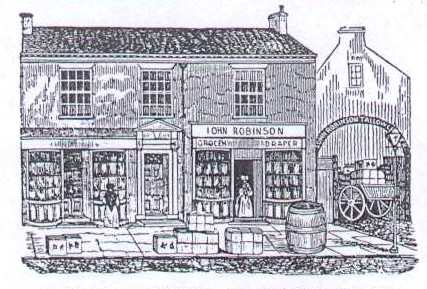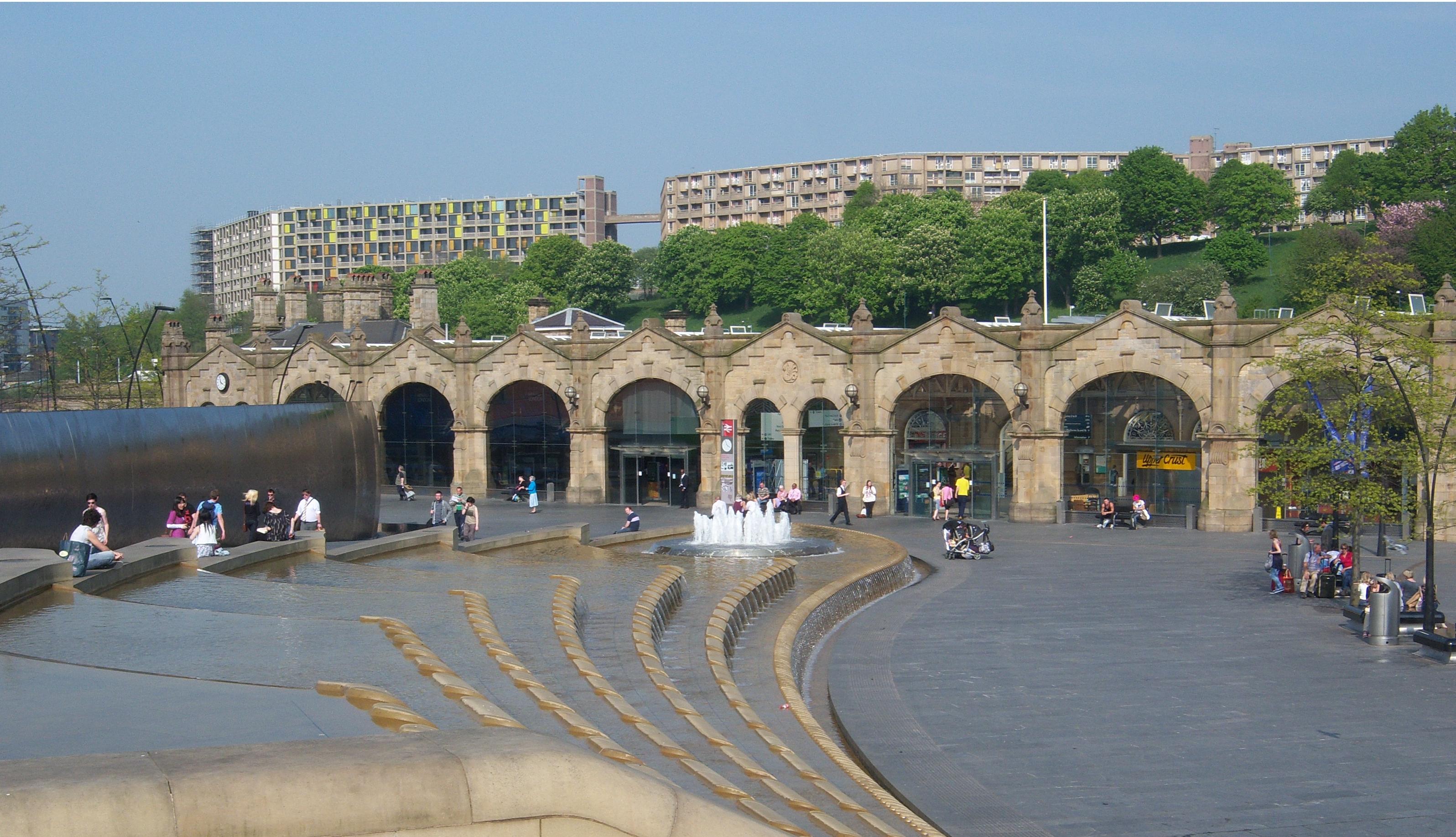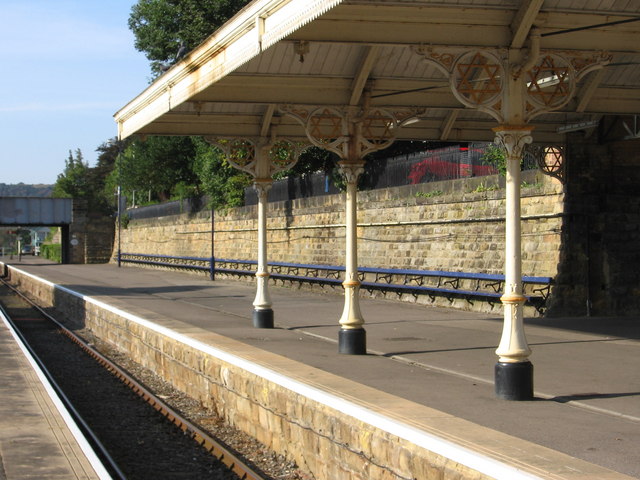|
Driffield Railway Station
Driffield railway station serves the town of Driffield in the East Riding of Yorkshire, England. It is located on the Yorkshire Coast Line and is operated by Northern, providing all passenger train services. History The station was opened by the York and North Midland Railway on 6 October 1846, at the same time as the line from Hull to Bridlington. The independent Malton & Driffield Railway company obtained parliamentary approval to build a branch line between there and Malton in the same year, but more than six years would pass before it was ready for traffic, the first train running in May 1853. This was never more than a rural branch line, but the final route into the town, from Selby via Market Weighton (opened on 1 May 1890), proved rather more important as it soon became busy with holiday traffic from the West Riding heading for the resorts further up the coast. Today, though only the original coast line remains in use, the Malton line having succumbed to road competiti ... [...More Info...] [...Related Items...] OR: [Wikipedia] [Google] [Baidu] |
Driffield
Driffield, also known as Great Driffield, is a market town and civil parish in the East Riding of Yorkshire, England. The civil parish is formed by the town of Driffield and the village of Little Driffield. By road, it is north-east of Leeds, north-east of Sheffield, east of York, north of Hull and south-east of Middlesbrough. Driffield is named ''The Capital of the Wolds'', due to its location sitting centrally within the Yorkshire Wolds. According to the 2011 UK census, Driffield parish had a population of 13,080, an increase on the 2001 UK census figure of 11,477. The town was listed in the 2019 Sunday Times report on the Best Places to Live in northern England. History Driffield is of Anglo-Saxon origin, and the name is first attested in the ''Anglo-Saxon Chronicle'' where King Aldfrith of Northumbria died on the 14 December 705. It is also found in ''Domesday Book'' of 1086, meaning "dirty (manured) field". A Bronze Age mound outside Driffield was excavated in ... [...More Info...] [...Related Items...] OR: [Wikipedia] [Google] [Baidu] |
Market Weighton
Market Weighton ( ) is a town and civil parish in the East Riding of Yorkshire, England. It is one of the main market towns in the East Yorkshire Wolds and lies midway between Hull and York, about from either one. According to the 2011 UK census, Market Weighton parish had a population of 6,429, an increase on the 2001 UK census figure of 5,212. History The 19th-century English lexicographer Sir William Smith proposed Market Weighton as the location of the still-undiscovered Roman camp of Delgovicia. Historically the town was listed in the ''Domesday Book'' as "Wicstun" and was granted its charter to become a market town in 1251. Notable architecture includes: a parish church, parts of which are Norman, the Londesborough Arms (an 18th-century coaching inn), a Wesleyan chapel, a Methodist chapel and a high street still recognisable from the 19th century. Other sights of interest include the post office, the duck pond and Station Farm. Market Weighton history includes Will ... [...More Info...] [...Related Items...] OR: [Wikipedia] [Google] [Baidu] |
Former York And North Midland Railway Stations
A former is an object, such as a template, gauge or cutting die, which is used to form something such as a boat's hull. Typically, a former gives shape to a structure that may have complex curvature. A former may become an integral part of the finished structure, as in an aircraft fuselage, or it may be removable, being using in the construction process and then discarded or re-used. Aircraft formers Formers are used in the construction of aircraft fuselage, of which a typical fuselage has a series from the nose to the empennage, typically perpendicular to the longitudinal axis of the aircraft. The primary purpose of formers is to establish the shape of the fuselage and reduce the column length of stringers to prevent instability. Formers are typically attached to longerons, which support the skin of the aircraft. The "former-and-longeron" technique (also called stations and stringers) was adopted from boat construction, and was typical of light aircraft built until the ad ... [...More Info...] [...Related Items...] OR: [Wikipedia] [Google] [Baidu] |
1846 Establishments In England
Events January–March * January 5 – The United States House of Representatives votes to stop sharing the Oregon Country with the United Kingdom. * January 13 – The Milan–Venice railway's bridge, over the Venetian Lagoon between Mestre and Venice in Italy, opens, the world's longest since 1151. * February 4 – Many Mormons begin their migration west from Nauvoo, Illinois, to the Great Salt Lake, led by Brigham Young. * February 10 – First Anglo-Sikh War: Battle of Sobraon – British forces defeat the Sikhs. * February 18 – The Galician slaughter, a peasant revolt, begins. * February 19 – United States president James K. Polk's annexation of the Republic of Texas is finalized by Texas president Anson Jones in a formal ceremony of transfer of sovereignty. The newly formed Texas state government is officially installed in Austin. * February 20– 29 – Kraków uprising: Galician slaughter – Polish nationalists stage an uprising in the Free City of Kraków; ... [...More Info...] [...Related Items...] OR: [Wikipedia] [Google] [Baidu] |
Stations On The Hull To Scarborough Line
Station may refer to: Agriculture * Station (Australian agriculture), a large Australian landholding used for livestock production * Station (New Zealand agriculture), a large New Zealand farm used for grazing by sheep and cattle ** Cattle station, a cattle-rearing station in Australia or New Zealand **Sheep station, a sheep-rearing station in Australia or New Zealand Communications * Radio communication station, a radio frequency communication station of any kind, including audio, TV, and non-broadcast uses ** Radio broadcasting station, an audio station intended for reception by the general public ** Amateur radio station, a station operating on frequencies allocated for ham or other non-commercial use ** Broadcast relay station ** Ground station (or Earth station), a terrestrial radio station for extraplanetary telecommunication with satellites or spacecraft ** Television station * Courier station, a relay station in a courier system ** Station of the ''cursus publicus'', a sta ... [...More Info...] [...Related Items...] OR: [Wikipedia] [Google] [Baidu] |
Northern Franchise Railway Stations
Northern may refer to the following: Geography * North, a point in direction * Northern Europe, the northern part or region of Europe * Northern Highland, a region of Wisconsin, United States * Northern Province, Sri Lanka * Northern Range, a range of hills in Trinidad Schools * Northern Collegiate Institute and Vocational School (NCIVS), a school in Sarnia, Canada * Northern Secondary School, Toronto, Canada * Northern Secondary School (Sturgeon Falls), Ontario, Canada * Northern University (other), various institutions * Northern Guilford High School, a public high school in Greensboro, North Carolina Companies * Arriva Rail North, a former train operating company in northern England * Northern Bank, commercial bank in Northern Ireland * Northern Foods, based in Leeds, England * Northern Pictures, an Australian-based television production company * Northern Rail, a former train operating company in northern England * Northern Railway of Canada, a defunct railway in ... [...More Info...] [...Related Items...] OR: [Wikipedia] [Google] [Baidu] |
Railway Stations In Great Britain Opened In 1846
Rail transport (also known as train transport) is a means of transport that transfers passengers and goods on wheeled vehicles running on rails, which are incorporated in tracks. In contrast to road transport, where the vehicles run on a prepared flat surface, rail vehicles (rolling stock) are directionally guided by the tracks on which they run. Tracks usually consist of steel rails, installed on sleepers (ties) set in ballast, on which the rolling stock, usually fitted with metal wheels, moves. Other variations are also possible, such as "slab track", in which the rails are fastened to a concrete foundation resting on a prepared subsurface. Rolling stock in a rail transport system generally encounters lower frictional resistance than rubber-tyred road vehicles, so passenger and freight cars (carriages and wagons) can be coupled into longer trains. The operation is carried out by a railway company, providing transport between train stations or freight customer facilit ... [...More Info...] [...Related Items...] OR: [Wikipedia] [Google] [Baidu] |
DfT Category F1 Stations
The Department for Transport (DfT) is a department of His Majesty's Government responsible for the English transport network and a limited number of transport matters in Scotland, Wales and Northern Ireland that have not been devolved. The department is run by the Secretary of State for Transport, currently (since 25 October 2022) Mark Harper. The expenditure, administration and policy of the Department for Transport are scrutinised by the Transport Committee. History The Ministry of Transport was established by the Ministry of Transport Act 1919 which provided for the transfer to the new ministry of powers and duties of any government department in respect of railways, light railways, tramways, canals and inland waterways, roads, bridges and ferries, and vehicles and traffic thereon, harbours, docks and piers. In September 1919, all the powers of the Road Board, the Ministry of Health, and the Board of Trade in respect of transport, were transferred to the new ministry. ... [...More Info...] [...Related Items...] OR: [Wikipedia] [Google] [Baidu] |
Railway Stations In The East Riding Of Yorkshire
Rail transport (also known as train transport) is a means of transport that transfers passengers and goods on wheeled vehicles running on rails, which are incorporated in tracks. In contrast to road transport, where the vehicles run on a prepared flat surface, rail vehicles (rolling stock) are directionally guided by the tracks on which they run. Tracks usually consist of steel rails, installed on sleepers (ties) set in ballast, on which the rolling stock, usually fitted with metal wheels, moves. Other variations are also possible, such as "slab track", in which the rails are fastened to a concrete foundation resting on a prepared subsurface. Rolling stock in a rail transport system generally encounters lower frictional resistance than rubber-tyred road vehicles, so passenger and freight cars (carriages and wagons) can be coupled into longer trains. The operation is carried out by a railway company, providing transport between train stations or freight customer faciliti ... [...More Info...] [...Related Items...] OR: [Wikipedia] [Google] [Baidu] |
Sheffield Railway Station
Sheffield station, formerly ''Pond Street'' and later ''Sheffield Midland'', is a combined railway station and tram stop in Sheffield, England; it is the busiest station in South Yorkshire. Adjacent is Sheffield station/Sheffield Hallam University Sheffield Supertram stop. In 2017–18, the station was the 43rd-busiest in the UK and the 15th-busiest outside London. History 1870 - 1960 The station was opened in 1870 by the Midland Railway to the designs of the company architect John Holloway Sanders. It was the fifth and last station to be built in Sheffield city centre. The station was built on the 'New Line', which ran between Grimesthorpe Junction, on the former Sheffield and Rotherham Railway, and Tapton Junction, just north of Chesterfield. This line replaced the Midland Railway's previous route, the 'old road', to London, which ran from Sheffield Wicker via Rotherham. The new line and station were built despite some controversy and opposition locally. The Duke of Norf ... [...More Info...] [...Related Items...] OR: [Wikipedia] [Google] [Baidu] |
Doncaster Railway Station
Doncaster railway station is on the East Coast Main Line in England, serving the city of Doncaster, South Yorkshire. It is down the line from and is situated between and on the main line. It is managed by London North Eastern Railway. It is a major passenger interchange between the main line, Cross Country Route and local services running across the North of England. It is also the point for which London North Eastern Railway services branching off to diverge from the main route continuing north towards Edinburgh. History The railway station was built in 1849 replacing a temporary structure constructed a year earlier. It was rebuilt in its present form in 1938 and has had several slight modifications since that date, most notably in 2006, when the new interchange and connection to Frenchgate Centre opened. In May 2015, construction commenced on a new Platform 0 to the north-east of the station adjacent to the Frenchgate Centre on the site of the former cattle dock. It i ... [...More Info...] [...Related Items...] OR: [Wikipedia] [Google] [Baidu] |
Scarborough Railway Station
Scarborough railway station, formerly Scarborough Central, is a Grade II listed station serving the seaside town of Scarborough, North Yorkshire. It lies east of York and is one of the eastern termini on the North TransPennine route, operated by TransPennine Express. The station is also at the northern end of the Yorkshire Coast line and is reputed to have the longest station seat in the world at long. From 1907 until 2010 the station approaches were controlled from a 120-lever signal box named Falsgrave (at the outer end of platform 1 and close to the former excursion station at ). In its final years Falsgrave box controlled a mixture of colour-light and semaphore signals, including a gantry carrying 11 semaphores. The signal box was decommissioned in September 2010 and the gantry was dismantled and removed in October 2010. Its new home was Grosmont railway station, on the North Yorkshire Moors Railway. The new signalling is a relay-based interlocking with two- and three-asp ... [...More Info...] [...Related Items...] OR: [Wikipedia] [Google] [Baidu] |







